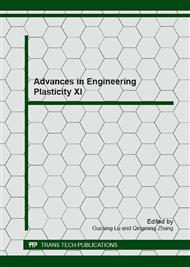p.193
p.197
p.201
p.205
p.211
p.215
p.219
p.223
p.227
Deformation and Recrystallization Textures of Surface Layers of Aluminum and Copper Sheets Cold-Rolled under Unlubricated Condition
Abstract:
The texture of rolled sheets is known to vary with depth from the surface to the center due to inhomogeneous deformation, which can be caused by a characteristic deformation zone geometry and friction between materials and rolls during rolling. In order to study the deformation and recrystallization (Rex) textures of the surface layers of Al and Cu sheets cold rolled without lubrication, 5 Al sheets were stacked and rolled by 88% and 4 Cu sheets were stacked and rolled by 93% in 4 passes at room temperature. The surface layers separated from the rolled sheets were annealed for 1 h at 500 °C for Al and at 550 °C for Cu. The deformation textures of the surface layers were characterized by different shear textures, which gave rise to very different Rex textures.
Info:
Periodical:
Pages:
211-214
Citation:
Online since:
January 2013
Authors:
Keywords:
Price:
Сopyright:
© 2013 Trans Tech Publications Ltd. All Rights Reserved
Share:
Citation:


